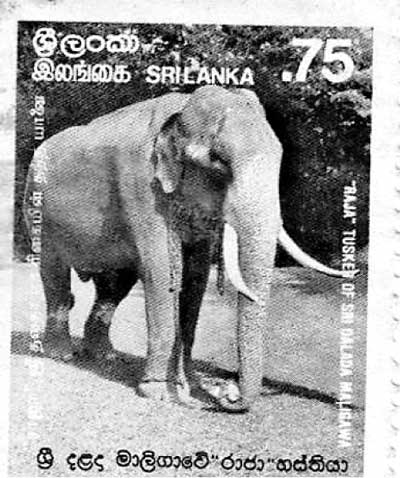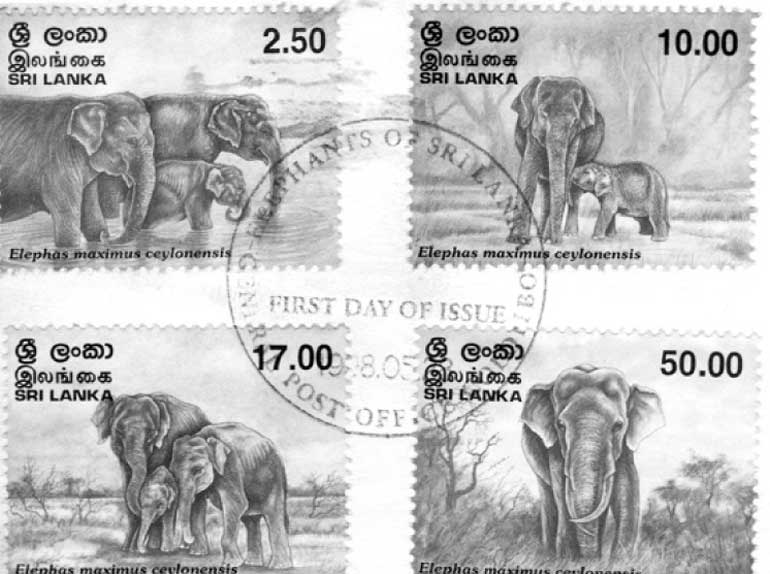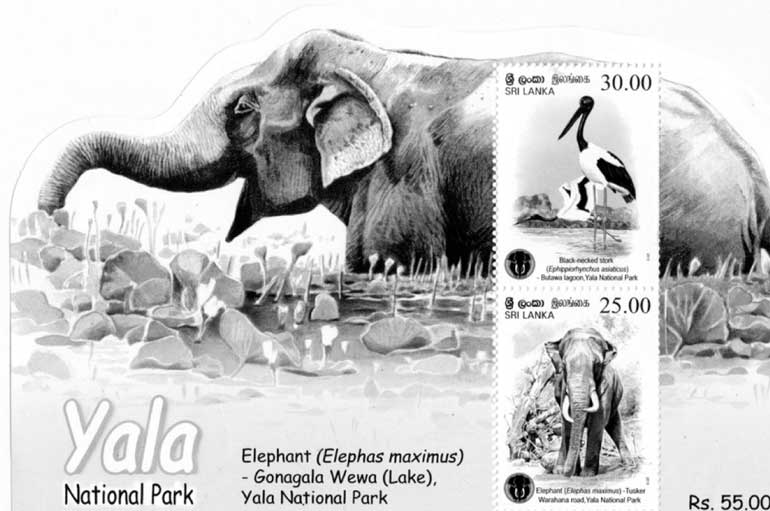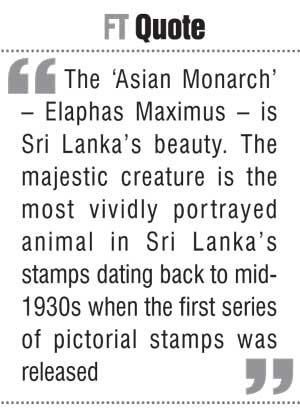Saturday Dec 06, 2025
Saturday Dec 06, 2025
Saturday, 5 March 2016 00:00 - - {{hitsCtrl.values.hits}}

The ‘se tenant’ issue of four stamps (each Rs. 5) titled ‘Elephants of Sri Lanka’ released on 5 August 1986 portrayed the majesty of the elephant best

Raja was honoured with the issue of a 75 cents stamp on 12 December 1989

‘Elephants of Sri Lanka’ was the theme of another set of four stamps with the accent on the family

At least two stamp releases on national parks featured the elephant; one was a tusker in Yala and the other a herd in Udawalawe
World Wildlife Day was on 3 March. The focus this year was on African and Asian elephants under the theme ‘The future of wildlife is ours’. It’s obvious that the focus is because the elephants are a fast-dwindling species, mainly as a result of illegal killings to get their tusks.
The ‘Asian Monarch’ – Elaphas Maximus – is Sri Lanka’s beauty. The majestic creature is the most vividly portrayed animal in Sri Lanka’s stamps dating back to mid-1930s when the first series of pictorial stamps was released.
In the days when Sri Lankan was a Crown Colony in the British Empire, a herd of wild elephants was featured in a set of four stamps issued on 1 January 1936. It was a 50-cent stamp with an inset of King George V, the British monarch and it was the first stamp depicting animals of Sri Lanka.
All the stamps in that era featured the British monarch. In 1938, the entire series of 12 pictorial stamps was re-issued featuring King George VI when he ascended the throne following the death of George V.
The ‘se tenant’ issue of four stamps (each Rs. 5) titled ‘Elephants of Sri Lanka’ released on 5 August 1986 portrayed the majesty of the elephant best.
As one stamp depicts, the trunk personifies the elephant. An adult elephant would use the trunk for anything up to 18 hours a day to gather nearly 400 pounds of food and around 40 gallons of water. The water is either sprayed into the mouth (for drinking) over its broad back (for dousing). As for their eating habits, they eat the leaves as well as the twigs and branches. Nature sees to it that it migrates from place to place allowing each feeding ground to regenerate.
Research shows that an elephant can live for about 65 to 70 years. As they grow old and with the molar or grinding teeth (these crush and pound the tough woody stems) at the back of the mouth getting worn, they try to survive on semi-solid or near-liquid food. Aged animals move towards water where they are able to pick up soft reeds and grasses.
Elephants usually move in small, well-knit family groups with two or three families sometimes getting together to form larger herds at feeding locations and watering places. A family rarely exceeds 15 with fathers, mothers, aunts, brothers and sisters forming the group. There is a great sense of affection and attachment for one another, particularly for the young babies. An elderly female is usually the head of the family mainly for purposes of discipline, and movement for food and water. A strong bull looks after the security angle.
Elephants rarely charge man unless they are provoked, pestered or taken by surprise. An elephant about to charge would stamp its forelegs and swing the large ears forward. A terrifying trumpet is followed by a deep-throated roar. And then it charges. Though they  have highly-developed scent and hearing, they have poor eyesight.
have highly-developed scent and hearing, they have poor eyesight.
Raja, the Maligawa tusker
Among Sri Lankan elephants, the most famous was Raja, the royal tusker that carried the relic casket in the Esala Perahera for over half a century. The sense of discipline and the solemn and magnificent demeanour displayed by Raja while carrying the casket won the admiration and respect of millions of devotees over the long period.
In August 1986, President J.R. Jayewardene declared Raja as a national treasure for the invaluable service rendered to the religion. Raja was the only tusker in Asia and the second in the world to be so honoured. Raja was honoured with the issue of a 75 cents stamp on 12 December 1989, one-and-a-half years after Raja’s death.
Raja’s is a fascinating story. It was captured on 5 January 1925 when it was 12 years old from the jungles in the eastern coast close to Batticaloa. The 4ft 5ins tall animal had excellent features fit to be the royal tusker. According to tradition, the four legs, the trunk, the tail and the genitals of a royal tusker should touch the ground. The spine should be flat. The head when raised should give a dignified look. Raja possessed all these.
Raja’s owner, Tikiri Banda Mampitiya Disawa of Giragama Walauwa, Yatinuwara who had bought the animal for Rs. 3,300 in December 1925, offered Raja to the Dalada Maligawa on 31 July 1937 along with another baby tusker. They were received by the Diyawadana Nilame, Tikiri Banda Ratwatte, on behalf of the Maligawa and the Buddhist public.
In the last years, Raja was well cared for by the Diyawaradana Nilame, Niranjan Wijeratne who tried his utmost to save the tusker when it started falling ill from 1986. Raja died at 10:16 in the morning on 16 July 1988 at the ripe age of 75.
Raja can still be seen in the Maligawa premises in Kandy where it has been stuffed with cotton wool and preserved.
The family
‘Elephants of Sri Lanka’ was the theme of another set of four stamps with the accent on the family. The stamp bulletin described the elephant as “a magnificent creature which is our largest mammal, averages eight feet in height and weighs between four to five tons when fully grown.” Some elephants grow impressive tusks while others only have short ones which are called tushes. The female gives birth to a 100kg baby once in four years.
The bulletin also touched on the man-elephant conflict mentioning that due to the loss of their natural habitat as a result of man’s every expanding development activities, the elephants had been pushed from their original home into the dry zone.
The first-ever nationwide elephant census conducted in August 2011 showed that there are a total of 5,879 elephants across the island. Of those only 122 elephants were tuskers. Elephants are found over almost the entire dry zone.
The national parks are home to many elephants. At least two stamp releases on national parks featured the elephant. One was a tusker in Yala and the other a herd in Udawalawe.